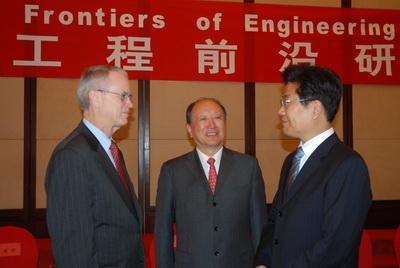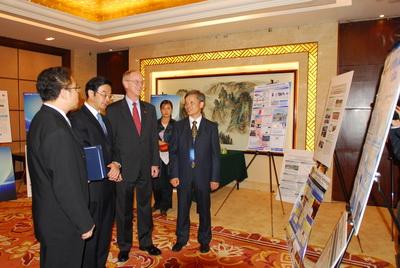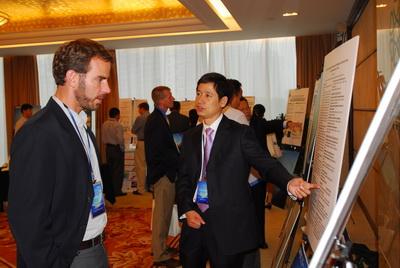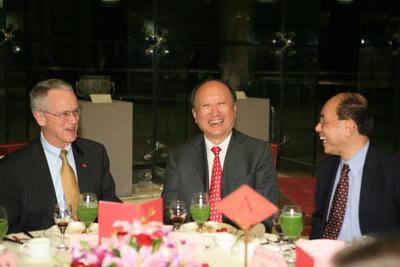Introduction to Frontiers of Engineering
The Frontiers of Engineering program brings together through three-day meetings a select group of emerging engineering leaders from industry, academe, and government labs to discuss pioneering technical work and leading edge research in various engineering fields and industry sectors. The goal of the meetings is to introduce these outstanding engineers (aged 30-45) to each other, and through this interaction facilitate collaboration in engineering, the transfer of new techniques and approaches across fields, and establishment of contacts among the next generation of engineering leaders. There are five Frontiers of Engineering meetings every year: the U.S. Frontiers of Engineering Symposium held each year and a rotating schedule of the German-American Frontiers of Engineering Symposium (GAFOE), the Japan-America Frontiers of Engineering Symposium (JAFOE), the Indo-American Frontiers of Engineering Symposium (IAFOE), the China-America Frontiers of Engineering Symposium (CAFOE), and the EU-US Frontiers of Engineering Symposium (EU-US FOE).
Each Frontiers symposium covers four topics that vary from year to year. Examples from past symposia include: visualization for design and display, nanotechnology, advanced materials, robotics, simulation in manufacturing, energy and the environment, optics, intelligent transportation systems, MEMS, design research, bio-engineering, counterterrorism technologies, and quantum computing. Following each talk, there is substantial time devoted to discussion. In addition, breakout sessions, poster sessions, and other events offer ample opportunity for informal exchange among the participants. An alumni program supports continuing contact among the participants. Attendees find the programs useful and unique in their ability to bring together a diverse group for the purpose of exchanging information about engineering developments and challenges across disciplines.
Initiation of China-America Frontiers of Engineering Symposium
Since 1995, the National Academy of Engineering (NAE) has held an annual Frontiers of Engineering (FOE) symposium that brings together 100 outstanding engineers (aged 30-45) from U.S. companies, universities, and government to discuss leading-edge research and technical work across a range of engineering fields.The goal of the 2 -day symposium is to introduce these engineers to each other, challenge them to think about developments and problems at the frontiers of areas different from their own, and thereby facilitate collaborative work, the transfer of new techniques and approaches across fields, and establishment of contacts among the next generation of leaders in engineering in order to build and sustain U.S. innovative capacity. In 2008, the China-America Frontiers of Engineering program was initiated. In June 2008, Xu Kuangdi, President of CAE (Chinese Academy of Engineering), and Charles Vest, President of National Academy of Engineering (NAE) in the United States, held a working meeting to discuss matters of bilateral cooperation between CAE and NAE, when Vest attended the 9th General Assembly of CAE in Beijing. One of the cooperation between CAE and NAE was to jointly organize the first China-America Frontiers of Engineering Symposium in China. Both sides agreed to say that the co-organized China-America Frontiers of Engineering Symposium was of strategic significance. The symposium will be held every other year, with location alternating by country.
2009 China-America Frontiers of Engineering Symposium
CAFOE aims to bring together outstanding, early-career Chinese and American engineers from industry, universities, and other research institutions to introduce their areas of engineering research and technical work, thereby facilitating an interdisciplinary transfer of knowledge and methodology that could eventually lead to collaborative networks of engineers from the two countries. The total number of participants, including organizers, speakers, and other participants, numbers approximately 60, with 30 engineers from each country. Participation is by invitation only.
The first symposium, supported by grants from the ChineseAcademy of Engineering, Hunan Province, Hunan University, U. S. National Academy of Engineering, and the Grainger Foundation, was held on October 19-21, 2009, in Changsha, Hunan Province, People s Republic of China. Xu Kuangdi, President of CAE and former Vice-Chairman of CPPCC, Charles M. Vest, President of NAE, Zhang Chunxian, Secretary of Hunan Provincial CPC Committee and Director of the Standing Committee of People s Congress of Hunan Province, Suo Zhigang, Allen E. and Marilyn M. Puckett Professor of Mechanics and Materials at Harvard University and Member of NAE, and Zhong Zhihua, President of Hunan University and Member of CAE etc., attended the opening ceremony of the China-America Frontiers of Engineering Symposium on October 19, 2009 and delivered their enthusiastic welcome speeches.
Zhang Chunxian, Secretary of Hunan Provincial CPC Committee and Director of the Standing Committee of People s Congress of Hunan Province, expressed in his welcome speech his warm welcome and hoped that the CAFOE Symposium, held in HunanProvince, would facilitate rapid development of HunanProvince. He maintained that As an important province in central China, Hunan is blessed with abundant resources, ideal geographic location, rich culture, and solid industrial foundation. It is competitive in such industries as agriculture, engineering mechanics, railway transportation facilities, iron and steel and nonferrous metals. The overall scientific and technological strength of Hunan province stands at the forefront in China, with a multitude of world-level scientific results, such as hybrid rice, high performance carbon and carbon composite, Galaxy computers and maglev train. In recent years, the potential of science and technology talents is fully tapped to promote the development of Hunan as an innovative province. New scientific and technological achievements have continuously been scored, pushing Hunan province to the top in patent licensing in central and western China. Engineering technology is a key element to evaluate the scientific and technological strength and overall competitiveness of a region and a country.

In his welcome speech, Xu Kuangdi, President of CAE emphasized that The CAFOE is good in that it is an excellent form of cooperation between our two academies, which brings together talented early and mid-career engineers from China and U.S. for experience sharing and mutual benefit. The CAFOE is important in that it aims at fostering high level and strategic-minded engineering leaders in our two countries in the future. The cooperation and friendship built up among you through the Symposium will be life-long and is conducive to even more strengthened friendship and solid cooperation in the future.
Charles M. Vest, President of NAE, firstly expressed his thanks that ChineseAcademy of Engineering, Hunan Provincial Government and HunanUniversity succeeded in holding the first China-America Frontiers of Engineering Symposium (CAFOE) which was initiated by Xu Kuangdi, President of CAE and himself in Beijing a year ago. He briefed the background and history of FOE (Frontiers of Engineering) held by NAE and the cooperation between NAE and other countries such as German, Japan, India, China and EU. He pointed out that CAFOE had at least two important meanings. One is that China has a long history of engineering science and technology with many major inventions much earlier than the United States. And another is that as China is in rapid development of economy and technology, joint symposiums between CAE and NAE would achieve the goals such as technology transfer through the exchange of advanced engineering technology between China and USA.
Zhou Qiang, Governor of Hunan Province and Vice-secretary of Hunan Provincial CPC Committee, attended the welcoming banquet and delivered his welcome speech. He said that The symposium held in Hunan would be of great and profound significance in that it would enhance the cooperation between China and USA in the frontiers of engineering and educate the early-career engineering talents. Engineering technology is an important force to promote social development and progress. In modern history, Engineering technology greatly contributed to the development and progress of the mankind, and produced many exciting stories. He introduced exciting and encouraging engineering development in HunanProvince, and mentioned the concept car designed and developed by Zhong Zhihua, President of Hunan University and Member of CAE, and the super hybrid rice developed by Yuan Longping, Professor of Agriculture University in Hunan and Member of CAE. He was sure that the CAFOE held in Hunan, Hunan Province would impel early-career engineering talents in HunanProvince to overcome the problems in the frontiers of engineering.
The U.S. co-chair for the 2009 symposium was Dr. Suo Zhigang, Allen E. and Marilyn M. Puckett Professor of Mechanics and Materials at HarvardUniversity. The Chinese co-chair was Dr. Zhong Zhihua, President of Hunan University. The organizing committee was composed of Chinese and U.S. engineers who determine the presentation topics and speakers for the symposium and assist in the selection of participants. The areas covered at the 2009 China-America Frontiers of Engineering Symposium were: Engineering and Public Health: Ensuring Food Safety, New Energy-Saving Technologies, Sustainability and Disaster Mitigation of Infrastructure, and Intelligent Transportation Systems.
The first session Engineering and Public Health: Ensuring Food Safety was co-organized by Li Ning, Professor of China Agricultural University and Member of CAE, and Bradley P. Marks, Professor of Bio-systems Engineering at Michigan State University. The session abstract is as follows: The national and international interconnectedness of the food production, processing, and distribution system creates significant challenges in engineering robust processes and systems that ensure protection of human health. This session will address the variety of points on this spectrum in which engineering plays a critical role in addressing these challenges. The first speaker, Wu Yongning from the ChineseCenter for Disease Control and Prevention, will address integrated risk analysis for controlling food safety. The second speaker, Nathan Anderson from the U.S. Food and Drug Administration, will address the application of risk assessment methodologies to food safety challenges, with particular focus on unique challenges of dealing with high degrees of uncertainty and critical gaps in the necessary body of knowledge. The third speaker, Zhang Dabing from ShinghaiJiaoTongUniversity, will discuss GMO analysis in China. The fourth speaker, Ferhan Ozadali from Nestl Nutrition in the U.S., will discuss the practical constraints involved in the adoption of novel, cutting-edge food safety technologies to ensure the protection of consumer health.
Wu Yongning, Professor of Department of Monitoring and Control for Contaminants, National Institute of Nutrition and Food Safety, Chinese Center for Disease Control and Prevention delivered his presentation entitled Capability Building of Food Safety: Where Do We Stand in China? Nathan Anderson from U.S. Food and Drug Administration gave his speech named The Food Safety Objective Approach to Risk-Based Process Design . GMOs Analysis in China was illustrated by Zhang Dabing, Professor of Department of Life Science and BiotechnologyShanghaiJiaoTongUniversity. Implementing Novel Food Technologies by Ensuring the Public Health A Risk-Based Process Validation Approach was presented by Ferhan Ozadali, Principal Scientist and Global Process Authority of Nestl .

The second session New Energy-Saving Technologies was co-chaired by Peng Suping, Professor of China University of Mining and Technology and Member of CAE, and Tina Salguero, Research Staff Chemist of HRL Laboratories. The abstract of this session reads: Sustainable energy meeting the energy needs of today without sacrificing the re-sources of future generations is one of the most important issues facing us today. During this time of increasing world energy consumption, declining fossil fuel resources, and serious environmental concerns, there is a pressing need for technologies that harness renewable energy, improve energy efficiency, and minimize greenhouse gas emission.
Examples of renewable energy sources include biofuels, solar power, wind power, wave power, geothermal power and tidal power. Fuel cells are an important component of the world s sustainable energy future because they offer zero-emissions electricity generation. The first two speakers of this session described recent developments in solid oxide fuel cells, particularly in new electrolyte materials that al-low these fuel cells to operate at intermediate temperatures. Some of this work has led directly to new materials for even more sustainable energy production via the thermo-chemical conversion of solar energy to chemical energy.
The third presentation described state-of-the-art progress in the area of hydrogen storage, which is a critical part of utilizing hydrogen fuel cells for transportation applications. A promising approach to both on-board (reversible) and off-board (non-reversible) hydrogen storage involves metal hydride compounds, in which hydrogen is chemically bonded to metal atoms. Recent advances include the use of metastable hydrides and chemical regeneration methods.
Technologies that solve environmental problems caused by coal consumption are also an important and pressing need.The fourth speaker of this session discussed direct coal liquefaction and carbon dioxide abatement technologies in China.
Materials Solutions for Energy Conversion and Storage: Fuel Cells and Solar Fuel Generators was delivered by Sossina M. Haile, Professor of Materials Science and of Chemical Engineering, California Institute of Technology. Han Minfang, Professor of China University of Mining & Technology (Beijing), gave her presentation entitled Solid Oxide Fuel Cell Development in China . New Approaches to Hydrogen Storage was given by Jason Graetz, Assistant Scientist of Energy Sciences & Technology at Brookhaven National Laboratory. Zhang Yuzhuo, President and CEO, Shenhua Group Corporation, illustrated his presentation named Direct Coal Liquefaction & CO2 Abatement Demonstration Project .
The third session Sustainable and Disaster-Resilient Infrastructure Systems was co-organized by Reginald DesRoches, Professor of Georgia Institute of Technology, and Li Hui, Professor of Harbin Institute of Technology. (Ou Jinping, President of Dalian University of Technology and Member of CAE, initially co-chaired this session with Prof. Reginald DesRoches, but he couldn t attend the symposium due to other official business. Hence, he recommended that Prof. Li Hui should take his place as the co-chair from Chinese side.) The abstract of this session is:
Infrastructure systems provide us with clean and safe water, reliable power, and a means for rapidly and safely transporting people and goods.Improving urban infrastructure systems is the key to economic growth, national security, and quality of life.In recent years, collapse of highway bridges and buildings, failure of dams and levees, outbreaks of water-borne diseases, repeated power outages, and increasingly delayed flights are an indication that our infrastructure systems may not be adequately resilient to the various stressors placed on them, including increasing populations in urban areas, ageing infrastructure, increasing demands for energy, water, and materials, and the effects of natural hazards. The National Academy of Engineering s recently released Grand Challenges for Engineering for the 21st century noted that restoring and improving urban infrastructure will be one of the key challenges in the 21st century.The report also noted that urban areas are particularly susceptible to damage from natural disasters, and solutions to these problems must be figured out with sustainability in mind.
Recent advances in new materials, robotics, sensor technology, nanotechnology, and computer technology have set the stage for the design, maintenance, and rehabilitation of the next generation of infrastructure systems that are more robust, resilient, and sustainable in the face of natural hazards. The use of structural health monitoring systems, and associated tools for prognosis of infrastructure can dramatically enhance the safety and sustainability of civil infrastructure systems exposed to natural and man-made hazards. Similarly, advances in new materials, such as self-consolidating fiber reinforced concrete and weather steels, will provide infrastructure systems that are more durable and efficient.
Our first speaker discussed the role of monitoring, evaluation, design, and control in designing infrastructure systems to resist earthquake and wind induced loading. The second speaker highlighted the recent disruptions to electric power grid infrastructure from earthquakes, wind storms, and ice storms. Our third speaker stressed the role of a variety of advanced materials in the design of new highway overpass bridges. In addition, the speaker discussed the role of seismic response modification devices and state-of-the-art sensors to economically achieving a new level of seismic safety and a new level of long-term durability for highway bridges. The fourth speaker discussed the role of information technology in managing complex infrastructure systems. In particular, the speaker discussed the role of intelligent sensors in natural hazard mitigation, controlling energy use, and asset management.
Bridges for the Flat World: Next-Generation Highway Bridge Structures was illustrated by Bozidar Stojadinovic, Professor of Department of Civil and Environmental Engineering from University of California Berkeley. Xie Qiang, Associate Professor of Department of Building Engineering from TongjiUniversity gave his speech Natural Disaster Evaluation and Mitigation of Electric Power Grid Infrastructures in China . The topic Ubiquitous Sensing at the Cyber-Physical Interface for Sustainable and Safe Infrastructure was delivered by Jerome Lynch, Assistant Professor of Department of Civil and Environmental Engineering at University of Michigan. Li Hui, Professor of Harbin Institute of Technology, presented her research entitled Monitoring, Evaluation, Design and Control for Life-Cycle Performance of Key Civil Engineering .
The fourth session Intelligent Transportation System was co-chaired by Darcy Bullock, Professor of Civil Engineering and Associate Director of Joint Transportation Research Program (JTRP) from PurdueUniversity, and Wu Jianping, Professor at Beijing University of Posts and Communications. The abstract of this session is as follows:
The term intelligent transportation system (ITS) refers to efforts to add information and communications technology to transport infra-structure and vehicles in an effort to improve transportation efficiency, environment impacts, energy consumption, safety and comfort. A typical intelligent transport system includes information (e.g. traffic data) collection, processing, modeling and application for traffic/system/vehicle management and traveler/costumer/driver information. Information and communication technology are the key technologies of ITS.

Magnetometers and inductive loops have been used for over forty years to provide presence and count detection for signalized arterials. More recently improved signal processing and roadside computational equipment has allowed devices to capture the raw wave form from these sensors. These new data elements can be used for improved tactical and strategic arterial management as well as high quality traveler information. Brian Fuller will introduce the technical foundation of this signature matching, the implementation architecture, and typical performance characteristics observed in an arterial environment. He further discusses the performance trade offs associated with various sensor placements relative to signalized intersections.

The rapid development of the Chinese economy over the past thirty years has resulted in the increased demand for passenger and freight transport considerably. Many cities are experiencing very bad traffic congestion, which results in significant delays, increased energy consumption and air pollution. Intelligent transport systems (ITS) have been introduced and conducted to take advantage of traffic management and control with significant social, economic and environmental benefits. Wu Jianping reviewed the major developments of ITS in China with special focus on the technologies of ITS implemented for the transport of 2008 Beijing Olympic Games.
Capacity of U-turn traffic at unsignalized median openings in divided highways impacts adjacent roads capacity. Road capacity information are one of the import information of ITS. Based on site study on 4-lane and 6-lane divided highways, Liu Pan found that the median nose width greatly affect the potential capacity of U-turns on 4-lane facilities. On 6-lane facilities, the conflicting traffic volume significantly affects the capacity of U-turns. The weighted conflicting traffic volume for U-turns on 6-lane streets equals 2.2 times the average opposing major street traffic volume in each lane. The Harders model provided reasonable capacity estimates for U-turns at median openings.
Probes is a broad term used to describe the monitoring of a sample of transportation system users as they pass predefined checkpoints.Although the field of Intelligent Transportation Systems is nearly 20 years old, the use of probe data has been extremely rare. In the talk of Jason S. Wasson, he introduced the concept of tracking consumer electronic devices carried by passengers (and vehicles) to obtain high fidelity travel time data for a variety of transportation facilities (free-ways, arterials, and airport security lines). After a brief introduction to the fundamental technology, the talk focused on a series of case studies drawn from freeway deployments in Indiana. Case studies illustrated the influence of construction work zones, incidents, weather, and special events on system performance. The talk concluded by summarizing how probe vehicle data is fundamentally changing how state agencies approach traffic management as well as identifying lessons learned and deployment challenges.
Estimating Arterial Travel Time Using Vehicle Signature Re-identification was presented by Brian Fuller, VP of Engineering at Sensys Networks. Wu Jianping, Professor at Beijing University of Posts and Communications, gave his speech entitled The Intelligent Transport Systems in Beijing Olympic Games . Developing Procedures for Estimating Capacity of U-turn Movement at Median Openings was illustrated by Liu Pan, Professor of School of Transportation from Southeast University of Nanjing. Jason Wasson from Indiana Department of Transportation delivered his speech entitled Application of Probe Data for Transportation System Management .
At the banquet, Sun Baitao, Research Professor and Deputy Director of Institute of Engineering Mechanics at China Earthquake Administration delivered his Dinner Speech Wenchuan Earthquake and its Implications in Engineering .
During the intervals of the CAFOE symposium, all the participants from both sides, as planned, visited Yuelu Academy (predecessor of Hunan University with a history of more than 1, 000 years), State Key Laboratory of Advance Desing and Manufacturing for Vehicle Body at Hunan University, and State Key Laboratory of Chemo/Biosensing and Chemometrics at Hunan University.
The participants from both sides were quite satisfied with the successful organization of this symposium, just as Charles M. Vest, President of NAE sincerely and humorously said that the success of this symposium went beyond our expectation, just like the successful 2008 Beijing Olympic Games, which would be difficult for us to surpass.
2011 China-America Frontiers of Engineering Symposium
The second symposium will be held on March 28-30, 2011, at BeckmanCenter, Irvine, California, USA. The U.S. co-chair for the 2009 symposium was Dr. Suo Zhigang, Allen E. and Marilyn M. Puckett Professor of Mechanics and Materials at HarvardUniversity. The Chinese co-chair was Dr. Zhong Zhihua, President of Hunan University. The organizing committee comprised of Chinese and U.S. engineers who determine the presentation topics and speakers for the symposium and assist in the selection of participants. The areas covered at the 2009 China-U.S. FOE symposium were: Wireless Communications, Bio-inspired Engineering, Advanced Vehicles and Mobility, and Ocean Engineering. (By Li Weirong, December 2009)
Related News
Photos
More>>trade
- 101st CAE Forum on Engineering Science and Technology Held in Hohhot
- Think Twice before Publicizing, Advocating and Promoting the Production of Stone
- Promoting Rapeseeds Industry Development by Transforming Mode of Development
- The 10th China Patent and High-Tech Products Expo Opened in Jining, Shandong
- "Rail Electric Traction Engineering Forum Held in Zhuzhou
market
- CAE President Zhou Ji Attended Serial Events Dedicated to Combining Efforts of
- The 2nd Meeting of The Operating Condition and Countermeasures of China s High
- CAE Vice President Xie Kechang Attended the 6th Annual Conference of Cross
- Fighting the Next Superbug
- The 2nd "China Rare Earth Industry Development Forum" Held in Baotou
finance
- Honorary Chairman Xu Kuangdi Met with Press Group with China US Exchange
- CAE President Zhou Ji Met with IVA President Mr. Bjorn O. Nilsson
- CAE President Zhou Ji Met with INAE President, Dr. Prem Goel
- Enlarged Meeting for CAE Environment and Textile Engineering Academic Division
- China, Sweden Vow to Enhance Cooperation in Engineering Sciences





